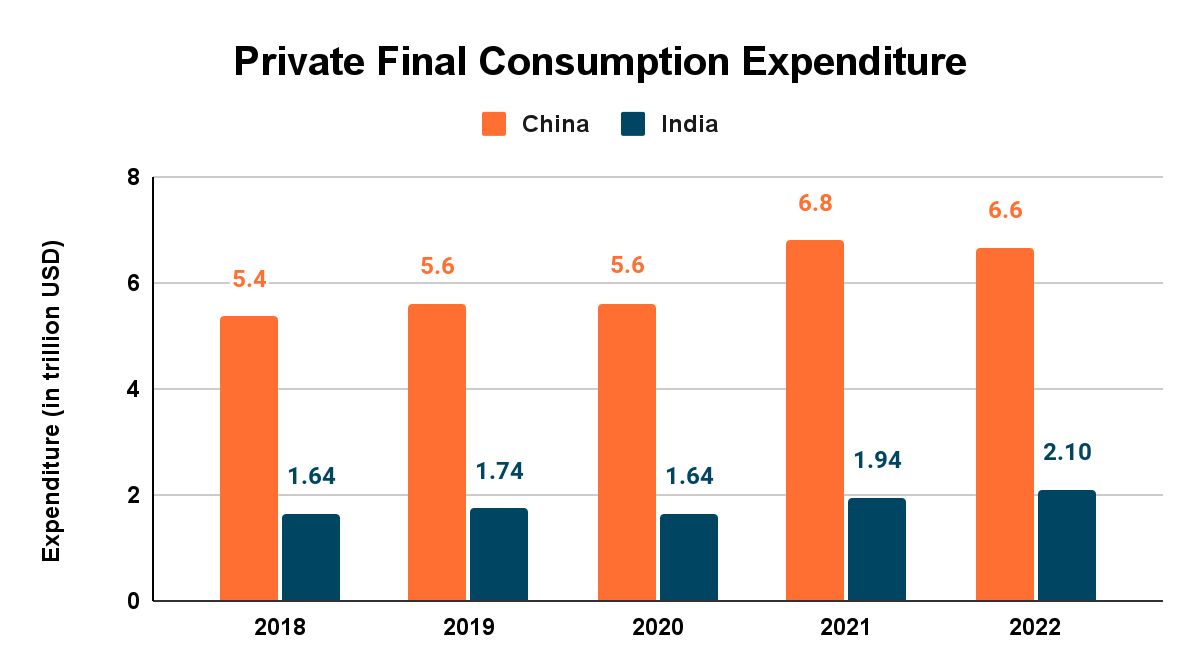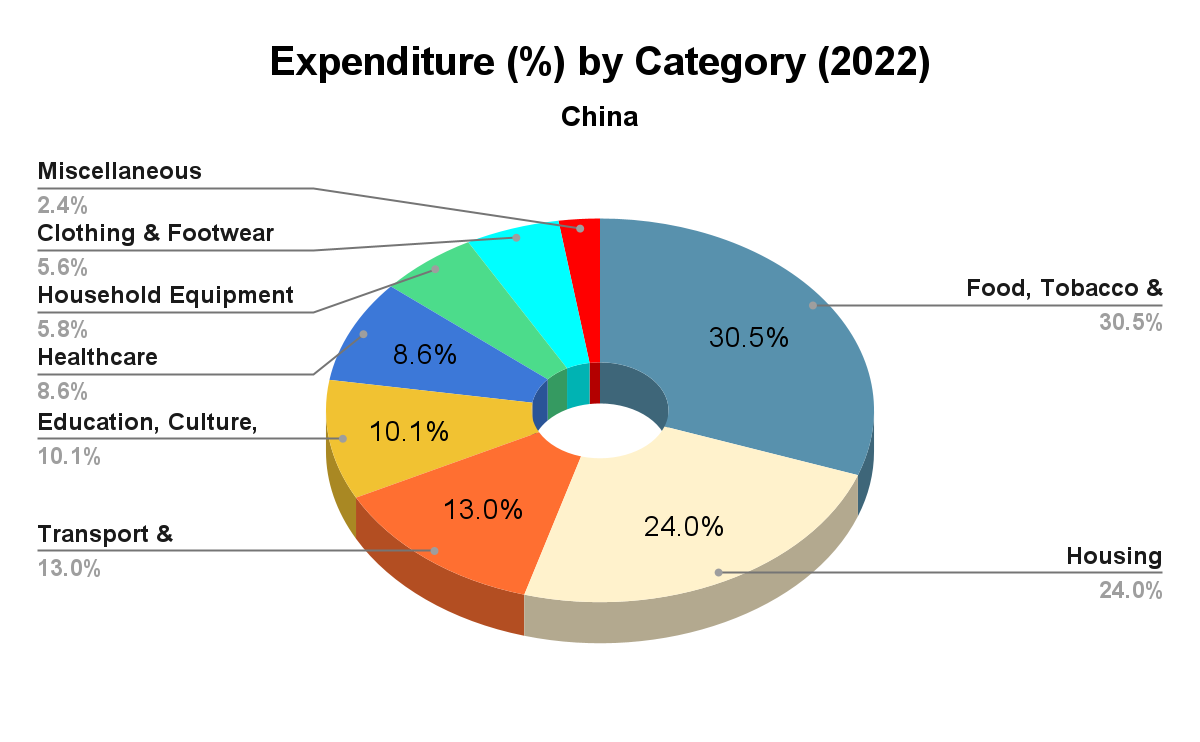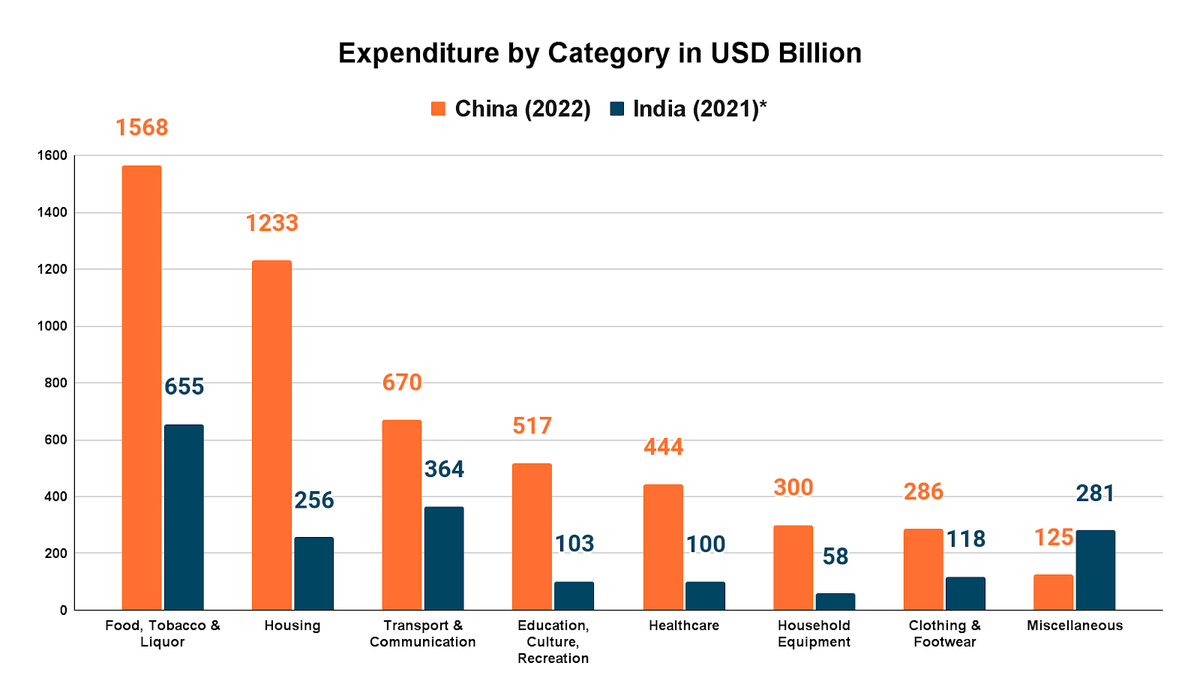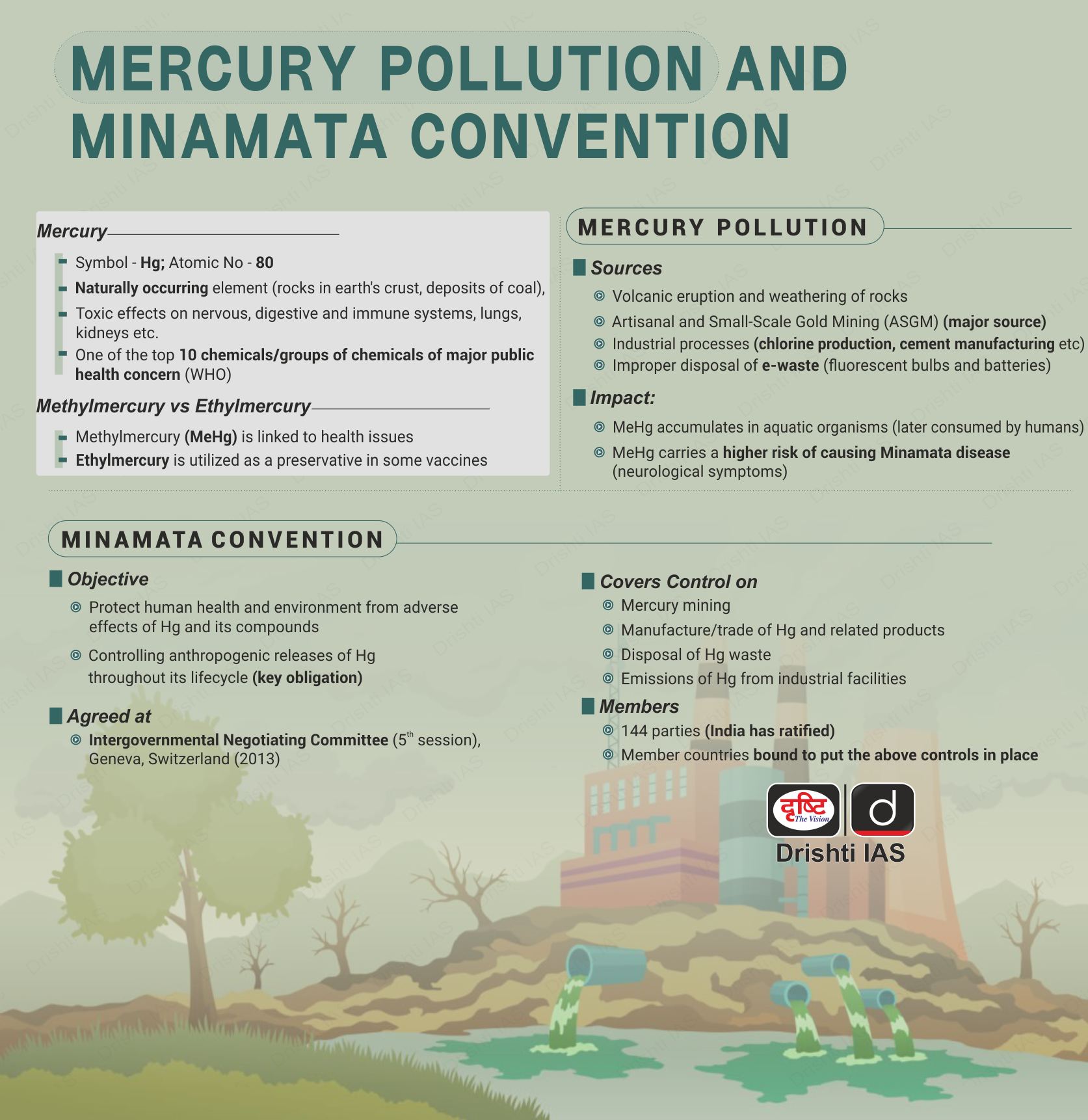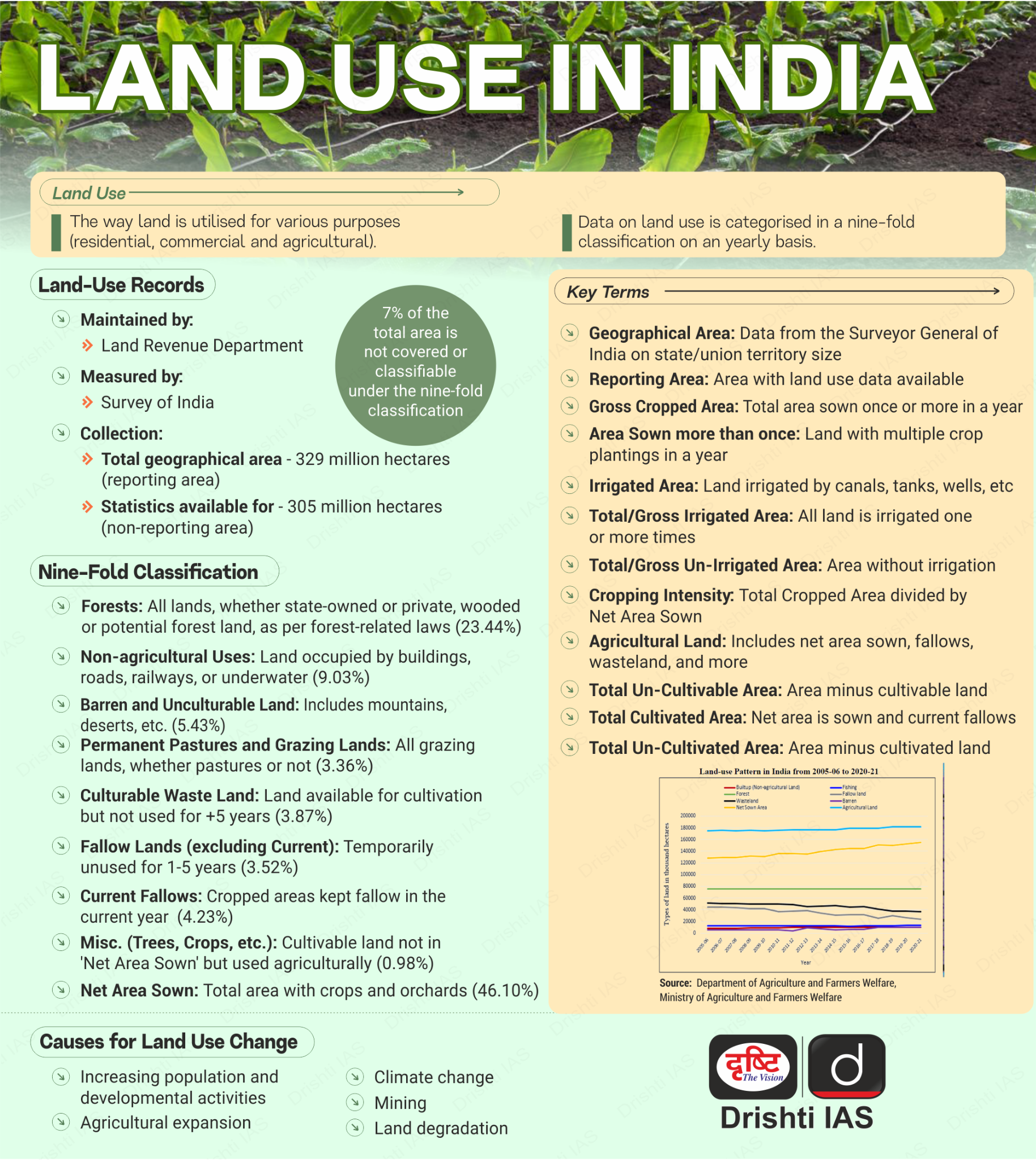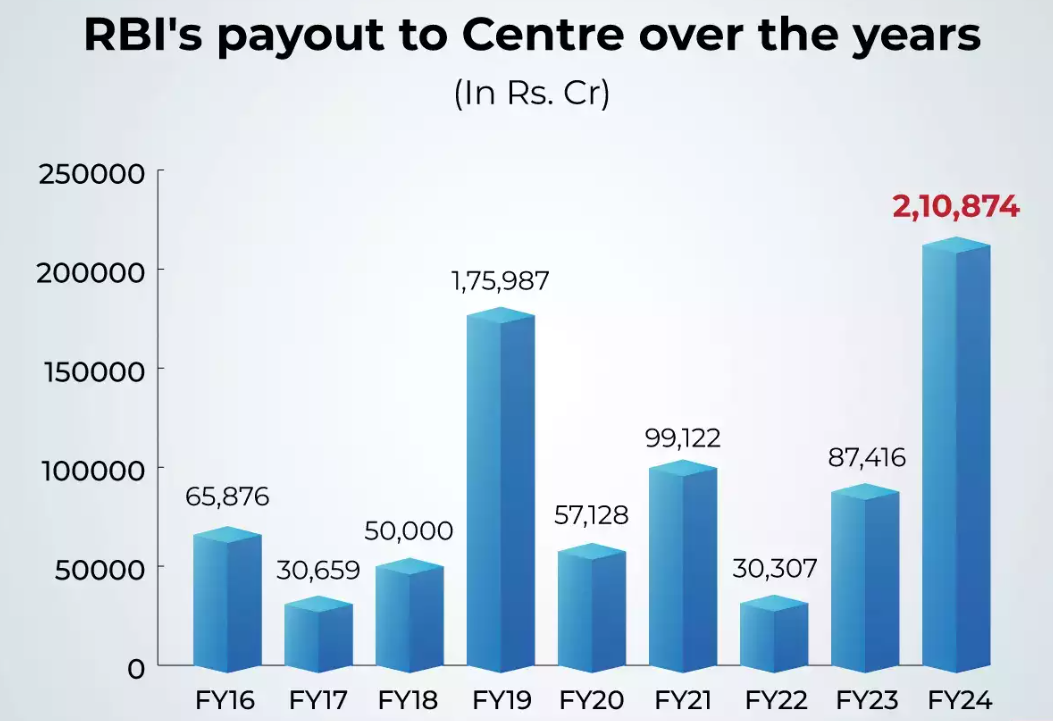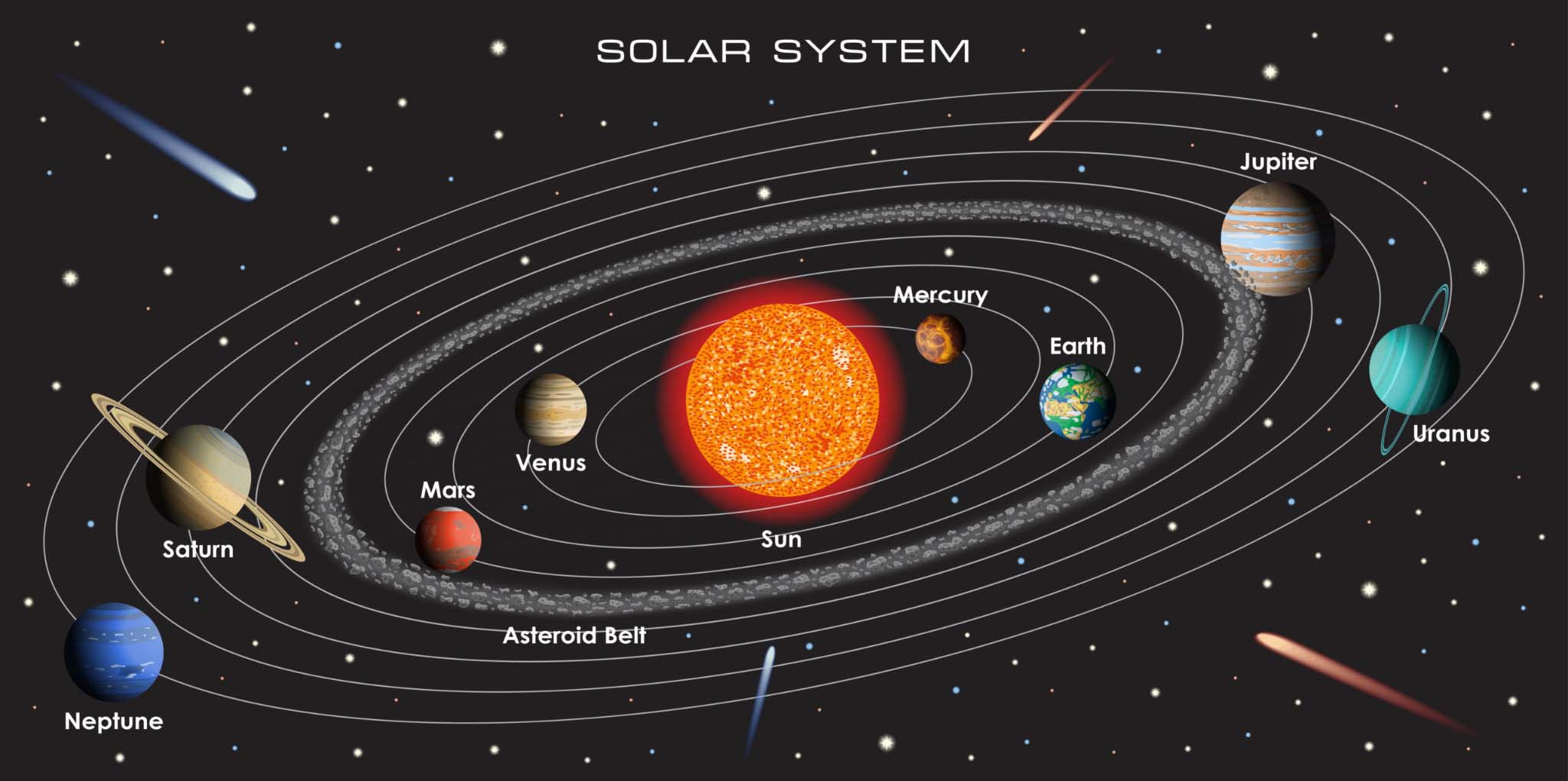Infographics
International Big Cat Alliance
Read More: Status of Leopards in India 2022, Sustainable Finance for Tiger Landscapes Conference

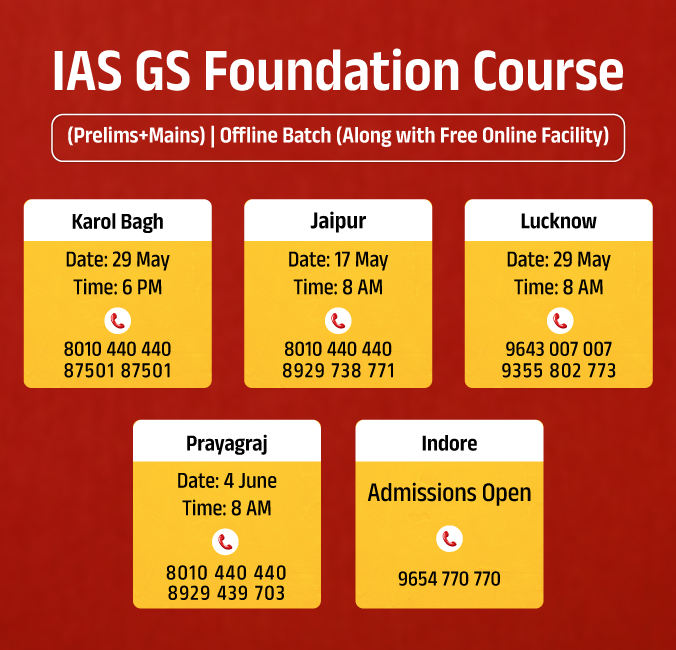
Indian Economy
Indian Manufacturing Needs Product Sophistication
For Prelims: Gross Domestic Product (GDP), Make in India, Industry 4.0, Production-Linked Incentive (PLI), PM Gati Shakti-National Master Plan, Bharatmala Project, Sagarmala Project.
For Mains: Growth Drivers of the Manufacturing Sector in India, Challenges Related to India’s Manufacturing Sector, Recent Government Initiatives for Growth of the Industrial Sector in India.
Why in News?
Recently, the Finance Minister stated that the Indian manufacturing sector should focus on developing more sophisticated products, and the government is ready to provide policy support to achieve this goal.
What is the Status of India’s Manufacturing Sector?
- The manufacturing sector contributes 17% of India's GDP and employs over 27.3 million workers, playing a significant role in the country's economy.
- The Indian government aims to increase the manufacturing sector's contribution to 25% of the economy's output by 2025 (goal of Make in India).
- The increasing significance of manufacturing is driven by the strong performance of important sectors such as automotive, engineering, chemicals, pharmaceuticals, and consumer durables.
- Manufacturing exports reached a record high of USD 447.46 billion in FY23, showing a 6.03% growth compared to the previous year (FY22) when exports were USD 422 billion.
- India's key industrial sectors (8 core industries) saw a slowdown in January 2024, experiencing their slowest growth in 15 months. Growth slipped to 3.6%, a significant decline from December 2023 (4.9%) and January 2023 (9.7%).
- The Index of Industrial Production (IIP) from April-October 2023 stood at 143.5, which signifies a growth of 43.5% compared to the base year (2011-12).
- IIP is a composite indicator of the general level of industrial activity in the economy. It is calculated and published by the Central Statistical Organisation (CSO) every month.
- Capacity utilisation for the manufacturing sector increased to 68.3% in Q2 (2021-22) from 60.0% in the previous quarter due to the easing of the second wave of the Covid-19 pandemic.
- Capacity utilization refers to the manufacturing and production capabilities that are being utilised by a nation or enterprise at any given time.
- Sectors like Drugs and Pharmaceuticals (+46%), Food Processing Industries (+26%), and Medical Appliances (+91%) witnessed increased FDI inflows.
- As per the Economic Survey 2021-22, in spite of Covid-related disruptions, there is a trend of positive overall growth of Gross Value Addition (GVA) in the manufacturing sector.
- The total employment in this sector has increased from 57 million in the year 2017-18 to 62.4 million in the year 2019-20.
What are the Opportunities for Manufacturing Sector in India?
- Broad Domestic Market and Demand: The Indian manufacturing sector has seen strong demand for their goods from both domestic and external clients.
- PMI in May 2024 (58.8), shows expansion in India's manufacturing sector.
- Sectoral Advantage: Key manufacturing sectors in India, such as chemicals, pharmaceuticals, automotive, electronics, industrial machinery, and textiles, have experienced significant growth in recent years.
- In India, pharmaceutical manufacturing costs are 30%–35% lower than US and Europe.
- Outreach to the Market of Global South: As per the UN, Indian manufacturing is shifting in Global Value Chains (GVC) from Europe to Asia. The share of foreign value-added (FVA) in India’s domestic final demand from Global Southern partners rose from 27% in 2005 to 45% in 2015.
- This shift presents opportunities for Indian firms to establish their own GVCs and for India to become a regional growth pole.
- Rise of MSME: MSMEs currently contribute approximately 30% to GDP, playing a crucial role in driving economic growth and contributing nearly 45% of India's total exports.
- Robust demand: India's manufacturing products are experiencing rising demand, both domestically and internationally.
- The manufacturing sector of India has the potential to reach USD 1 trillion by 2025.
- Competitive Advantage: Growth in India's manufacturing sector, driven by increased production capacity, cost advantages, supportive government policies, and private investment, is setting the stage for sustained economic growth in the coming years..
Government Policy for the Manufacturing Sector
What are the Challenges to the Manufacturing Sector in India?
- Reliance on outdated technology and inadequate infrastructure hinders the ability of Indian manufacturers to compete globally and meet international quality standards.
- Shortage of Skilled Workforce: As per World Bank, only 24% of India's workforce possesses the skills required for complex manufacturing jobs incontrast to 52% in the US and 96% in South Korea.
- High Input Cost: As per RBI (2022) states that logistics costs in India are 14% higher compared to the global average which impacts the overall competitiveness of Indian manufacturing industry.
- Complex Regulatory Environment: It acts as deterrent for businesses looking to set up manufacturing units in India.
- Land Acquisition is a complex process in India, NITI Aayog suggests Land Titling Act yet to pass by legislature.
- Competition from China and Import Dependence: In 2023-24, China accounted for almost 42% of India's textiles and clothing imports, 40% of machinery, and 38.4% of electronics imports.
- As per WTO, China remains the world's leading manufacturer, accounting for nearly 30% of global manufacturing output in 2022.
Way Forward
- Need for Industry 4.0 in Indian Manufacturing: As per reports manufacturing sector could achieve a 25% share in GDP through Industry 4.0 technologies.
- Indian manufacturers are increasingly embracing digital transformation by investing 35% of their operating budgets towards technology investment, which needs to be increased further.
- Investment in Infrastructure: Enhancing the standard and accessibility of infrastructure, and reduction in logistics may lead to increased investment and business interest in the manufacturing industry.
- Promoting Export-Oriented Manufacturing: Encouraging the development of export-oriented manufacturing could help Indian businesses tap into new markets and increase their competitiveness.
- This could involve providing support for businesses looking to enter new markets or implementing policies that incentivise export-oriented manufacturing.
- Financial Assistance: Many MSMEs struggle to access credit for export-related activities. Enhancing SMEs' access to finance in the manufacturing sector can support their growth and development.
- Enabling Regulations: Simplifying and making regulations more efficient could lighten the load on businesses and promote increased investment in the manufacturing industry.
- More Emphasis on Skill Development: Increasing the availability of training and skill development programs could alleviate the shortage of skilled labour in the manufacturing industry and enhance its competitive edge.
- Vietnam has transformed into a global manufacturing hub, due to its’ relatively large, well-educated and skilled labour force.
|
Drishti Mains Question: Assess the current state of India's manufacturing sector, including the progress made under the 'Make in India' initiative. What are the key challenges hindering India’s manufacturing growth? |
UPSC Civil Services Examination, Previous Year Questions (PYQs)
Prelims
Q. In the ‘Index of Eight Core Industries’, which one of the following is given the highest weight? (2015)
(a) Coal production
(b) Electricity generation
(c) Fertilizer production
(d) Steel production
Ans: (b)
Q. Recently, India’s first ‘National Investment and Manufacturing Zone’ was proposed to be set up in (2016)
(a) Andhra Pradesh
(b) Gujarat
(c) Maharashtra
(d) Uttar Pradesh
Ans: (a)
Q. What is/are the recent policy initiative(s)of Government of India to promote the growth of manufacturing sector? (2012)
- Setting up of National Investment and Manufacturing Zones
- Providing the benefit of ‘single window clearance’
- Establishing the Technology Acquisition and Development Fund
Select the correct answer using the codes given below:
(a) 1 only
(b) 2 and 3 only
(c) 1 and 3 only
(d) 1, 2 and 3
Ans: (d)
Mains
Q.1 “Industrial growth rate has lagged behind in the overall growth of Gross-Domestic-Product(GDP) in the post-reform period” Give reasons. How far are the recent changes in Industrial Policy capable of increasing the industrial growth rate? (2017)
Q.2 Normally countries shift from agriculture to industry and then later to services, but India shifted directly from agriculture to services. What are the reasons for the huge growth of services vis-a-vis the industry in the country? Can India become a developed country without a strong industrial base? (2014)


Economy
Consumption Comparison of India-China
For Prelims: International Monetary Fund (IMF), Gross Domestic Product (GDP) Ratio, Fertility Rate.
For Mains: Differences Between the Economies of India and China, Steps that Can be Taken to Improve the Indian Economy
Why in News?
In 2023, India became the world's most populous country (with a population of around 1.44 Billion), surpassing China. It has significant consequences on domestic consumption in the two countries.
- This was due to China's declining birth rate (6.4 births per 1,000 people) and total fertility rate (~1%), leading to a negative population growth rate for the first time in six decades. As a result, China is facing a rising dependency ratio.
- In contrast, India's population is expected to continue growing and reach its peak around 2060, despite reaching replacement levels with a total fertility rate of 2.1.
United Nations Department of Economic and Social Affairs (UNDESA)
- It was formed in 1948. It is a pioneer of the Sustainable Development Goals (SDGs).
- It brings the global community together to work towards common solutions to the world’s most pressing problems.
- It helps countries translate their global commitments into national action in the economic, social and environmental spheres.
Key Terms:
- Birth Rate: It is a demographic measure that indicates the number of live births occurring during a given year per 1,000 people in a population.
- Total Fertility Rate (TFR): It is the average number of children a woman would be expected to have over her lifetime, given current age-specific fertility rates.
- Unlike the birth rate, which is a measure of births per 1,000 people in a population per year, the TFR provides a broader perspective on reproductive behaviour and potential population growth.
- Dependency Ratio: It compares the proportion of individuals who are typically not in the labour force (dependents) to those who are usually in the labour force (the working-age population).
- Replacement Level Fertility: It refers to the number of children a woman needs to have in order to replace herself and her partner, ensuring that the population size remains stable from one generation to the next, without considering migration.
- The commonly cited figure for replacement level fertility is approximately 2.1 children per woman.
What are the the Consumption Comparison Between Indian and China?
- Consumer Size:
- Both India and China have a large consumer base. A consumer is anyone who spends more than USD12 a day, as per the Purchasing Power Parity (PPP).
- Addition to Consumer Base:
- According to the World Data Bank, China's consumer base increased by 31 million in 2024, whereas India saw an addition of 33 million consumers.
- Projections for 2025 suggest that China will add 32 million consumers, while India is expected to add 34 million.
- Private Final Consumption Expenditure (PFCE): It contributes more than 58% to India’s GDP, while it contributes only 38% to China’s economy.
- PFCE is a major component of India’s Gross Domestic Product (GDP) and reflects consumer spending, which is a critical driver of economic activity.
- PFCE is a key economic indicator that measures the total value of all goods and services consumed by households and non-profit institutions serving households (NPISHs) within a country during a specific period.
- NPISHs are organisations that provide non-commercial services to individuals and families. Examples include religious institutions, charities, and social clubs.
- Final consumption, including government consumption expenditure, constitutes 68% of India's GDP and 53% of China's GDP.
- This implies that the government is a much bigger consumer in China than in India.
- Final Consumption Expenditure (FCE) is obtained by adding Government Expenditure and Private Final Consumption Expenditure (PFCE).
- The percentage of consumption expenditure is steadily increasing in India, while it has been on a decline in China.
- Differences in Consumption Patterns and Economic Development: India spends a higher proportion of their income on consumption.
- China's economic size (USD17.8 trillion) is around 5 times that of India's (USD 3.5 trillion) in Nominal terms and PPP terms, China’s GDP is approximately 2.5 times of India’s.
- In Nominal terms, China’s PFCE (USD 6.6 trillion) is only about 3.5 times higher than India's(USD 2.1 trillion) and in PPP terms, China’s PFCE is approximately 1.5 times that of India.
- Thus, consumption plays a more significant role in India's GDP compared to China.
- India will reach the same level of consumption as China at a much lower GDP figure (around USD 10 trillion for India compared to USD 17 trillion for China in nominal terms).
- PFCE Trends between 2018 and 2022:
- China's consumer spending has grown significantly in the past four years (USD 5.4 trillion in 2018 to USD 6.6 trillion in 2022), despite concerns.
- On the other hand, India’s figures have steadily increased from USD 1.64 trillion in 2018 to USD 2.10 trillion in 2022.
- In 2022, China's spending went down slightly, both overall (from USD6.8 trillion to USD6.6 trillion) and per person (from USD 4,809 to USD 4,730). Meanwhile, India's spending inched up in both categories.
- The difference in the expenditure between the two countries has widened from USD 3.8 trillion in 2018 to more than USD 4.5 trillion in 2022.
- China's consumer spending has grown significantly in the past four years (USD 5.4 trillion in 2018 to USD 6.6 trillion in 2022), despite concerns.
- Expenditure by Categories:
- Indian consumers allocate a larger portion of their spending towards basic needs like food, clothing, footwear, and transportation.
- This spending pattern reflects a developing economy where households prioritise necessities over discretionary spending.
- On the contrary, China's consumption basket reflects a market that is relatively advanced.
- While food and beverages make up the largest portion of China's consumption, their share of total consumption expenditure is decreasing, indicating a market that is becoming more mature.
- Also, it spends a larger proportion of its budget on housing, white goods, recreation, education, and healthcare compared to India.
- In advanced economies like the US, Japan, EU, Germany, and the UK, food expenditure is not the highest category.
- India spends about half as much as China on food, transport, communication, and clothing. Even though India's economy is only one-fifth the size of China's, the total expenditure in these sectors represents a similar percentage of their respective economies.
- As per Monthly Per Capita Consumption Expenditure (MPCE) report, both in rural and urban areas of India, the share of food in total expenses reduced and that in non-food expenses increased in 2022-23 compared with 2011-12.
- Indian consumers allocate a larger portion of their spending towards basic needs like food, clothing, footwear, and transportation.
What are the Factors Responsible for Difference in Consumption Pattern between India and China?
- Demographic Dividend:
- According to the World Bank Report, as of 2022, the median age in India is 28.4 years compared to China's 38.4 years.
- A younger population is likely in its early career stages, with rising income and a greater tendency to spend on establishing a household (housing, durables, transportation).
- According to the World Bank Report, as of 2022, the median age in India is 28.4 years compared to China's 38.4 years.
- Income Levels and Disposable Income:
- China has a larger and more established middle class with higher disposable incomes, enabling greater spending beyond essentials.
- In contrast, India's middle class is smaller, with more income directed towards basic necessities like food and transportation, resulting in less discretionary spending.
- Gross National Income(GNI) per capita in China for the year 2022 was USD 12,8501 and in India USD 2,5473.
- Stage of Economic Development:
- India is categorised as a Lower-middle-income country and China as an upper-middle-income country according to the World Bank .
- China's economy has transitioned from agriculture to manufacturing and then to services, driven by rapid industrialization, export-oriented growth, and infrastructure investment.
- India has moved more directly from agriculture to services, with significant growth in IT, finance, and professional services, while its manufacturing sector is still developing.
- Access to Credit:
- According to World Bank data, China has a much higher level of credit penetration compared to India.
- Nearly half of the adult population in China has a credit card, while only around 12% do in India.
- A significantly larger portion of the Chinese population (over 85%) has access to loans from financial institutions compared to India (around 57%).
- According to World Bank data, China has a much higher level of credit penetration compared to India.
- Urbanisation:
- While urbanisation is increasing in India, it lags behind China. This limits the reach of discretionary products and keeps consumption patterns focused on necessities.
- In 2020, 63.8% of China's population was urban, compared to 34.5% of India's population, according to the World Bank.
|
Drishti Mains Question: Analyse the consumption patterns between India and China. Discuss the factors that have influenced these patterns and assess their implications for economic development of India. |
UPSC Civil Services Examination, Previous Year Question:
Q. As per the NSSO 70th Round “Situation Assessment Survey of Agricultural Households”, consider the following statements: (2018)
- Rajasthan has the highest percentage share of agricultural households among its rural households.
- Out of the total agricultural households in the country, a little over 60 percent belong to OBCs.
- In Kerala, a little over 60 percent of agricultural households reported to have received maximum income from sources other than agricultural activities.
Which of the statements given above is/are correct?
(a) 2 and 3 only
(b) 2 only
(c) 1 and 3 only
(d) 1, 2 and 3
Ans: (c)
Q. In a given year in India, official poverty lines are higher in some States than in others because (2019)
(a) poverty rates vary from State to State
(b) price levels vary from State to State
(c) Gross State Product varies from State to State
(d) quality of public distribution varies from State to State
Ans: (b)

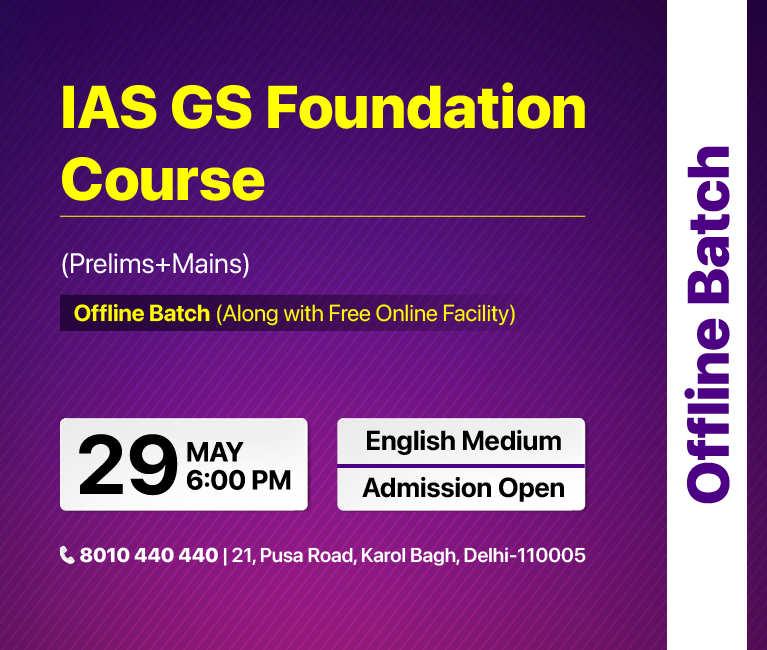
Important Facts For Prelims
Initiative to Eliminate Mercury-Containing Medical Devices
Why in News?
The governments of Albania, Burkina Faso, India, Montenegro, and Uganda have united to combat chemical pollution by launching a USD 134-million project to eliminate the use of mercury in medical devices.
What are the Key Highlights of the Initiative to Eliminate Mercury?
- The initiative is led by United Nations Environment Programme (UNEP), funded by Global Environment Facility (GEF), and executed by World Health Organisation (WHO), aiming to reduce the impact of healthcare on the environment and human health.
- It aims to support global efforts in improving the management of mercury waste and promote the use of alternatives.
- The project aims to phase out mercury-added thermometers and sphygmomanometers at a rate of 20% per year, improving the lives of over 1.8 million people.
- Medical thermometers and sphygmomanometers (devices that measure blood pressure) contain mercury and are harmless as long as they remain intact.
- Instances of breakages and improper disposal of medical devices release mercury vapour that contaminates surroundings both air and water.
- Inhalation of these mercury vapours can cause damage to the lungs, kidneys and nervous system.
What is Mercury?
- About: Mercury is a naturally occurring element found in the Earth's crust. It is considered by the WHO as one of the top ten chemicals or groups of chemicals of major public health concern.
- Applications:
- Mercury's high coefficient of thermal expansion and easy visibility make it suitable for use in traditional thermometers and barometers.
- It has been used in various chemical and mining processes, including the production of chlorine and mining of gold.
- Mercury-wetted switches are used in various electrical applications because of it's conductivity and low resistance.
What is the Minamata Convention on Mercury Pollution?
UPSC Civil Services Examination, Previous Year Questions (PYQs)
Prelims
Q. Indiscriminate disposal of used fluorescent electric lamps causes mercury pollution in the environment. Why is mercury used in the manufacture of these lamps? (2010)
(a) A mercury coating on the inside of the lamp makes the light bright white.
(b) When the lamp is switched on, the mercury in the lamp causes the emission of ultra-violet radiations.
(c) When the lamp is switched on, it is the mercury which converts the ultra-violet energy into visible light.
(d) None of the statement given above is correct about the use of mercury in the manufacture of fluorescent lamps
Ans: (b)


Geography
Global Impact of Land Squeeze
For Prelims: International Panel of Experts on Sustainable Food Systems (IPES-Food), National Land Records Modernization Programme (NLRMP), National Food Security Act (NFSA), 2013, National Mission on Sustainable Agriculture (NMSA)
For Mains: Key takeaways regarding land squeeze from International Panel of Experts on Sustainable Food Systems (IPES-Food) Report, Land Use in India, India’s Initiatives to Tackle the Issue of Land Squeeze and Food Insecurity
Why in News?
A recent study conducted by the International Panel of Experts on Sustainable Food Systems (IPES-Food) focusses on the unprecedented ‘land squeeze’, threatening farmers and food production.
- Land squeeze refers to the situation where the demand for land for various purposes (agriculture, urbanisation, infrastructure, etc.) outpaces the available cultivable land.
What are the Key Highlights of the Report?
- The report warns of prevalent "land squeeze" due to rising land prices, land grabs, and carbon schemes, threatening farmers and food production.
- Globally, the top 1% of the world’s largest farms now control 70% of the world’s farmland.
- As land becomes scarce, it can be converted from productive agricultural land to other uses, impacting food production
- Between 2008-2022, there has been a doubling of global land prices.
- This increase has been particularly pronounced in Central-Eastern Europe, where prices have tripled.
- "Green grabs," land acquisitions are evidently motivated by environmental concerns, now account for approximately 20% of large-scale land deals.
- Green grabbing refers to the large-scale acquisition or control of land and resources for environmental purposes, often with negative social and economic consequences. It's essentially land grabs done under the guise of environmental protection.
- Over half of the land designated by governments for carbon removal projects presents a potential risk of interference with the livelihoods of small-scale farmers and Indigenous people.
- Carbon offset markets are expected to quadruple in the next 7 years
What are the Key Reasons Behind Land Squeeze?
- Land Grabs:
- Large-scale acquisitions of land by governments, corporations, and speculators are displacing farmers and Indigenous communities.
- These acquisitions are mainly for resource extraction (mining, logging) or export-oriented agriculture.
- Rising Population and Demands:
- The increasing global population along with the huge demand for food, feed, fiber and fuel is putting lots of pressure on the availability of the land.
- Shifts in Global Food Production Systems:
- It involves the transfer of large areas of land towards industrial agriculture like Concentrated Animal Feeding Operations (CAFO) and monoculture farming practices.
- Industrial agriculture is the large-scale, intensive production of crops and animals, often involving chemical fertilizers on crops and harmful use of antibiotics in animals.
- Also, there has been increased demand for land for biofuels and other non-food uses.
- It involves the transfer of large areas of land towards industrial agriculture like Concentrated Animal Feeding Operations (CAFO) and monoculture farming practices.
What is the Status of Land Use in India?
- India’s Initiatives to Tackle the Issue of Land Squeeze and Food Insecurity:
- Land Management and Utilisation:
- Improving Productivity and Reducing Food Wastage:
- Programs for Land and Soil Conservation:
What are the Key Impacts of Land Squeeze?
- Loss of Access and Control for Farmers and Rural Communities:
- Displacement and Dispossession: Land grabs and other pressures force small-scale farmers and indigenous communities off their land, disrupting their livelihoods and traditional ways of life.
- Threatens Food Security: With fewer farmers and less land available for food production, overall food security becomes threatened, particularly for local communities.
- Weakened Bargaining Power: Loss of land ownership puts farmers at a disadvantage in negotiating fair prices for their products from powerful agribusinesses.
- Exacerbated Rural Poverty: Limited access to land restricts opportunities for rural populations, trapping them in a cycle of poverty.
- Environmental Degradation:
- Unsustainable Practices: The focus on large-scale, export-oriented agriculture often leads to unsustainable land use practices, such as deforestation, soil depletion, and overuse of water resources.
- Loss of Biodiversity: Land conversion for mining, infrastructure, and industrial agriculture destroys natural habitats and threatens biodiversity.
- Increased Vulnerability to Climate Change: Degradation of soil health and loss of natural vegetation weaken ecosystems, making them more vulnerable to climate shocks.
- Social Unrest and Conflict:
- Competition for Resources: Competition for scarce land resources can lead to social tensions and conflicts between communities and investors.
- According to the report by IPES-Food, over half of the land designated by governments for carbon removal projects presents a potential risk of interference with the livelihoods of small-scale farmers and indigenous people.
- Instability and Outmigration:
- Loss of land and livelihood opportunities triggers rural-urban migration, putting pressure on urban resources and social services.
- Competition for Resources: Competition for scarce land resources can lead to social tensions and conflicts between communities and investors.
What are the Recommendations of the Report?
- Halt Land Grabs: Policies and regulations are needed to prevent land grabs and ensure land use decisions prioritise local communities and food security.
- Support Small-Scale Farmers: Investments in rural infrastructure, secure land tenure, and access to financing are crucial for empowering small-scale producers.
- Sustainable Land Management: Promote practices that protect soil health, conserve biodiversity, and ensure long-term food production.
- Fair Trade Policies: Trade agreements should be reformed to promote sustainable agriculture and protect the livelihoods of small-scale farmers.
Conclusion
The land squeeze is a complex issue demanding a multifaceted solution. By addressing the underlying causes and supporting small-scale food producers, we can ensure equitable access to land, protect our environment, and build a more sustainable food system for the future.
|
Drishti Mains Question: Q. Highlighting the threats of land squeeze discuss the land use pattern of India and challenges associated with it. |
UPSC Civil Services Examination Previous Year Question (PYQ)
Prelims
Q. With reference to the provisions made under the National Food Security Act, 2013, consider the following statements: (2018)
- The families coming under the category of ‘below poverty line (BPL)’ only are eligible to receive subsidised food grains.
- The eldest woman in a household, of age 18 years or above, shall be the head of the household for the purpose of issuance of a ration card.
- Pregnant women and lactating mothers are entitled to a ‘take-home ration’ of 1600 calories per day during pregnancy and for six months thereafter.
Which of the statements given above is/are correct?
(a) 1 and 2 only
(b) 2 only
(c) 1 and 3 only
(d) 3 only
Ans: (b)


International Relations
India’s Contribution to Counter-Terrorism Efforts
For Prelims: United Nations Counter-Terrorism Trust Fund (CTTF), UNOCT (United Nations Office of Counter-Terrorism), Global Counter-Terrorism Strategy, Countering Financing of Terrorism (CFT), Countering Terrorist Travel Programme (CTTP), UN Counter-Terrorism Implementation Task Force (CTITF), UN Counter-Terrorism Centre (UNCCT), Terrorism Financing
For Mains: Terrorism Financing, Border Security, Regional Stability, India’s Effort in Countering Terrorism
Why in News?
Recently India has made a significant financial contribution to the United Nations Counter-Terrorism Trust Fund (CTTF), marking a pivotal moment in its ongoing commitment to combating terrorism on a global scale.
- With its current contribution, India's cumulative financial support to the trust fund now stands at $2.55 million.
What is the UN Counter-Terrorism Trust Fund?
- About:
- The UN Counter-Terrorism Trust Fund (UNCTTF) aims to support global efforts in countering terrorism.
- It was established in 2009 and incorporated into the UN Office of Counter-Terrorism (UNOCT) in 2017.
- The fund focuses on enhancing the capacity of member states, particularly in Eastern and Southern Africa, to tackle significant challenges such as financing terrorism and curtailing the movement and travel of terrorists.
- The UN Counter-Terrorism Trust Fund (UNCTTF) aims to support global efforts in countering terrorism.
- Global Programs Supported by UNCTTF:
- Capacity Building: The Trust Fund assists member states in strengthening their ability to combat terrorism effectively.
- This assistance includes training for law enforcement agencies, improving legal structures, and enhancing the technical expertise of counter-terrorism personnel.
- Countering the Financing of Terrorism (CFT): The Trust Fund is vital for preventing and countering terrorism financing by strengthening regulatory frameworks, enhancing financial tracking capabilities, and promoting international cooperation.
- Countering Terrorist Travel Programme (CTTP): This program seeks to prevent terrorist movements by enhancing border security, utilising advanced passenger information, and promoting international information exchange and best practices.
- The Trust Fund also supports balanced implementation of the four pillars of the UN Global Counter-Terrorism Strategy; addressing terrorism's root causes, combating terrorism, building state capacity, and ensuring human rights are respected.
- Capacity Building: The Trust Fund assists member states in strengthening their ability to combat terrorism effectively.
United Nations Office of Counter-Terrorism (UNOCT)
- The United Nations General Assembly established the United Nations Office of Counter-Terrorism (UNOCT) in 2017.
- It was created to provide leadership on the General Assembly’s counter-terrorism mandates and to enhance coordination and coherence across the UN system's counter-terrorism activities.
- The UNOCT supports Member States in implementing the UN Global Counter-Terrorism Strategy,
What is India's Contribution to Global Counter-Terrorism Efforts?
- Bilateral:
- India conducts meetings of the Joint Working Groups with the United Kingdom, France, and the United States on counter-terrorism.
- Multilateral:
- BRICS: India has been actively pursuing the issue of terrorism in multilateral forums including BRICS which has yielded positive results including the formation of five sub-working groups under BRICS focusing on terrorist financing, online terrorism, radicalization, foreign terrorist fighters, and capacity-building.
- UNSC CTC: In 2022, India hosted a special meeting of the UNSC’s Counter Terrorism Committee (CTC) to discuss terror-financing through crypto-currency and use of drones in the new-age terrorism. India listed five points for the consideration of the CTC:
- Effective and sustained efforts to counter terror-financing.
- Normative efforts of the UN need to be coordinated with other fora like the Financial Action Task Force (FATF).
- Make sure that the Security Council’s sanctions regime is not rendered ineffective because of political reasons.
- International cooperation and concerted actions against terrorists and their sponsors including the dismantlement of terrorist safe havens, etc. are critical imperatives.
- Recognise these linkages and strengthen multilateral efforts to break against terrorism’s nexus with a transnational organised crime like arms and illicit drug trafficking.
- India’s Contribution to UNCTTF: India has been actively supporting programs aimed at combating the threat of terrorism thus underscoring its dedication to supporting multilateral efforts in the fight against terrorism.
- The financial aid is aimed at bolstering UNOCT’s initiatives, such as the Countering Financing of Terrorism (CFT) and the Countering Terrorist Travel Programme (CTTP).
- Significance:
- India’s collaborative efforts help in enhancing the capacities of countries’ to combat terrorism financing and prevent the movement of terrorists across borders.
- By addressing the growing threat of terrorism in Africa (via UNCTTF), India aims to assist African nations in their efforts to counter terrorism and promote regional stability.
- The steps align with India's emergence as a Global South leader and with India’s priority of zero tolerance for Terrorism.
Other Initiatives to Counter Terrorism
- International:
- Indias-specific:
What are the Challenges Related to Terrorism?
- No Global Definition of Terrorism: The absence of universally accepted definitions for terrorism makes classifying specific activities difficult, granting terrorists an advantage and enabling certain countries to block action at global institutions.
- Expanding Web of Terrorism: The internet offers terrorists an unregulated platform to craft and spread propaganda, tailoring messages to recruit new members and advance their cause across numerous websites and social media platforms.
- Terror Financing: Criminals launder an estimated two to nearly four trillion dollars annually, according to the IMF and World Bank, while terrorists conceal fund movements through charities and alternative remittance systems.
- Cyber Attack: The world is becoming digitally interconnected, with data as a valuable resource, where terrorists exploit cyber attacks to intimidate or coerce governments and societies for their goals.
Way Forward
- International Cooperation Against Terrorism: The international community must overcome political differences to combat terrorism universally, establish a global definition of terrorism, and impose sanctions on state sponsors to ensure global security and peace.
- Enhancing National Security: Strengthening military specialisation and intelligence-sharing can play a key role in enhancing national security and safeguarding against cross-border terrorist threats.
- Curbing Terror Financing: Effective combat against terrorist financing requires cross-border transaction monitoring, network tracking, and international cooperation among law enforcement agencies and adhering to global standards like FATF.
- Developing a Robust Cyber-Defence Mechanism: Establishing an adaptable cyber defence strategy is crucial, requiring a multi-layered approach to combat sophisticated threats from malicious actors targeting individuals, organisations, and critical infrastructure.
|
Drishti Mains Questions: Q1. Examine the evolving nature of terrorism in the 21st century and its impact on global peace and security. Q2. Discuss the recent concerns faced by India regarding terrorism, considering both internal and external dimensions. Evaluate the effectiveness of India's current counter-terrorism strategies in addressing these challenges. |
UPSC Civil Services Examination, Previous Year Questions (PYQs)
Mains
Q. The scourge of terrorism is a grave challenge to national security. What solutions do you suggest to curb this growing menace? What are the major sources of terrorist funding? (2017)
Q. Religious indoctrination via digital media has resulted in Indian youth joining ISIS. What is ISIS and its mission? How can ISIS be dangerous to the internal security of our country? (2015)
Q. Cyber warfare is considered by some defence analysts to be a larger threat than even Al Qaeda or terrorism. What do you understand by Cyber warfare? Outline the cyber threats which India is vulnerable to and bring out the state of the country’s preparedness to deal with the same. (2013)


Important Facts For Prelims
RBI Surplus Transfer to Government
Why in News?
The Reserve Bank of India (RBI) has approved a significant surplus transfer of Rs 2.11 lakh crore to the Central Government for the accounting year 2023-24.
- This transfer marks a substantial increase from the previous year's dividend, showcasing a notable rise in surplus income.
How does the RBI Determine the Allocation of Dividends?
- The surplus calculation was based on the Economic Capital Framework (ECF) recommended by the Bimal Jalan committee, which advised the RBI to maintain a Contingent Risk Buffer (CRB) between 5.5% and 6.5% of its balance sheet.
- This risk provisioning is made primarily from retained earnings and only then is the surplus income transferred to the government as dividends.
- This range includes provisions for monetary and financial stability risks as well as credit and operational risks.
- RBI transfers its surplus, which is the excess of income over expenditure, to the government as per Section 47 of the Reserve Bank of India Act, 1934.
- Reasons for the Increase in RBI's Surplus: As of March 2024, the RBI had USD 646 billion in foreign exchange reserves, with USD 409 billion parked in top-rated sovereign securities.
- The RBI’s gross dollar sales were lower in FY24 (USD 153bn) compared to FY23 (USD 213 bn).
- Despite lower dollar sales in FY24 compared to FY23, the RBI's management of foreign currency assets ensured continued high revenue.
- Income from Liquidity Adjustment Facility (LAF) operations also contributed to the overall surplus.
- The RBI’s gross dollar sales were lower in FY24 (USD 153bn) compared to FY23 (USD 213 bn).
| Reserve Bank of India's Sources of Income | |
| Source of Income |
|
| Expenditure |
|
| Surplus |
|
Bimal Jalan Committee Recommendations
- Formation:
- The RBI in 2018 constituted a six-member committee, chaired by former governor Dr Bimal Jalan, to review the current economic capital framework (ECF), after the Ministry of Finance asked the central bank to follow global practices.
- Recommendations:
- The panel proposed a clear separation of RBI's economic capital into two parts: Realised equity and Revaluation balances.
- Revaluation reserves include unrealised gains/losses in foreign currencies, gold, securities, and a contingency fund.
- Realised equity, or CRB, is funded by retained earnings to cover risks and losses.
- The committee suggested that the RBI should maintain a CRB within the range of 6.5% to 5.5% of the RBI's balance sheet.
- This would provide an adequate buffer against market risks, credit risks, and operational risks.
- The committee recommended that the RBI should transfer its surplus funds to the government only after maintaining the CRB within the suggested range.
- This would ensure that the RBI's financial resilience is not compromised while supporting the government's fiscal needs.
- The panel also suggested that the RBI’s ECF should be reviewed every five years.
- The panel proposed a clear separation of RBI's economic capital into two parts: Realised equity and Revaluation balances.
Note:
- The RBI Board's technical Committee, led by Y H Malegam in 2013, recommended a higher transfer of reserves and surplus to the government, which typically averages around 0.5% of the Gross Domestic Product (GDP) with a few exceptions.
UPSC Civil Services Examination, Previous Year Questions (PYQs)
Prelims
Q. Which of the following statements is/are correct regarding the Monetary Policy Committee (MPC)? (2017)
- It decides the RBI’s benchmark interest rates.
- It is a 12-member body including the Governor of RBI and is reconstituted every year.
- It functions under the chairmanship of the Union Finance Minister.
Select the correct answer using the code given below:
(a) 1 only
(b) 1 and 2 only
(c) 3 only
(d) 2 and 3 only
Ans: A
Q. If the RBI decides to adopt an expansionist monetary policy, which of the following would it not do? (2020)
- Cut and optimize the Statutory Liquidity Ratio
- Increase the Marginal Standing Facility Rate
- Cut the Bank Rate and Repo Rate
Select the correct answer using the code given below:
(a) 1 and 2 only
(b) 2 only
(c) 1 and 3 only
(d) 1, 2 and 3
Ans: B


Rapid Fire
Mystery Behind Venus’ Extreme Dryness
Recently, scientists have suggested that a reaction, called the HCO+ Dissociative recombination Reaction (DR) that occurs above the surface of Venus, is responsible for the disappearance of water in the planet.
- DR occurs when HCO+ absorbs an electron and breaks up into CO and a hydrogen atom which then escapes into space, losing out water without evaporation.
- Other reasons cited by scientists:
- Venus’ harsh atmosphere caused by a greenhouse effect from CO2.
- Venus’ proximity to the Sun (heat and UV rays breaking down water molecules into H and O2 atoms).
- Other reasons cited by scientists:
- Venus (Earth’s twin) is the second planet from the Sun, and the sixth largest planet.
- It is the 2nd brightest natural object in the night sky after the Moon.
- Venus has no moon or satellite of its own.
- Only Venus and Uranus rotate in a clockwise direction on their axis, while others rotate in anti-clockwise direction.
- A day on Venus is actually longer than a year, as it takes longer for Venus to complete one rotation on its axis than to orbit the Sun.
- It is the 2nd brightest natural object in the night sky after the Moon.
Read More: Venus' Tectonic History


Rapid Fire
Matua Community
The Matua community of West Bengal has been demanding the implementation of the Citizenship Amendment Act, 2019.
- The Matuas are a depressed class of Bengali Hindus who are part of the Scheduled Caste group of Bengal. Millions of Matuas have migrated to India before and after the 1971 war that created Bangladesh, fleeing religious persecution.
- The Namasudras (Matuas) constitute 17.4% of the total Scheduled Caste (SC) population in West Bengal, making them the second-largest group after the Rajbanshis in North Bengal.
- Harichand Thakur, a social reformer, is considered the founder of the Matua Mahasangha, a federation representing the Matua community.
- It opposed caste oppression and work towards education and social upliftment of Dalits.
Read more: Citizenship Amendment Act: Unpacked


Rapid Fire
Buddha Purnima
The President of India extends greetings on the occasion of Buddha Purnima, highlighting the significance of Lord Buddha's teachings.
- Buddha Purnima also known as Vesak, commemorates the birth of Prince Siddhartha Gautama, who later became known as Gautama Buddha and founded Buddhism.
- Celebrated primarily in South, Southeast, and East Asia, it falls on the full moon day of the Hindu month of Vaisakha, typically in April or May.
- It is considered a 'triple-blessed day' as it marks Buddha's birth, enlightenment, and Maha Parnirvana. It has been recognised by the United Nations as the ‘UN Day of Vesak’ since 1999.
Read more: Buddha Purnima


Rapid Fire
R21/Matrix-M Malaria Vaccine
Serum Institute of India (SII), the world’s largest vaccine manufacturer (by number of doses produced and sold globally), has shipped the first set of R21/Matrix-M malaria vaccines to countries in Africa.
- This vaccine has been developed by the University of Oxford and the Serum Institute of India.
- It has been recommended for use by the World Health Organization (WHO) after meeting required safety, quality and effectiveness standards.
- The first malaria vaccine, RTS,S/AS01 was recommended by WHO to prevent malaria in children in October 2021.
- Malaria is a life-threatening disease caused by the plasmodium parasite, which is transmitted to humans through the bites of infected female Anopheles mosquitoes.
- As per World Malaria report 2023, there were 249 million cases of malaria in 2022 compared to 247 million cases in 2021.
- In 2022, the African Region bore the heaviest malaria burden, with 94% of cases and 95% of deaths globally.
- India accounted for 1.4% of total malaria cases in the world and saw a 30% decline in malaria cases and 34% decline in deaths in 2022 as compared to the 2021.
Read more: R21/Matrix-M Malaria Vaccine



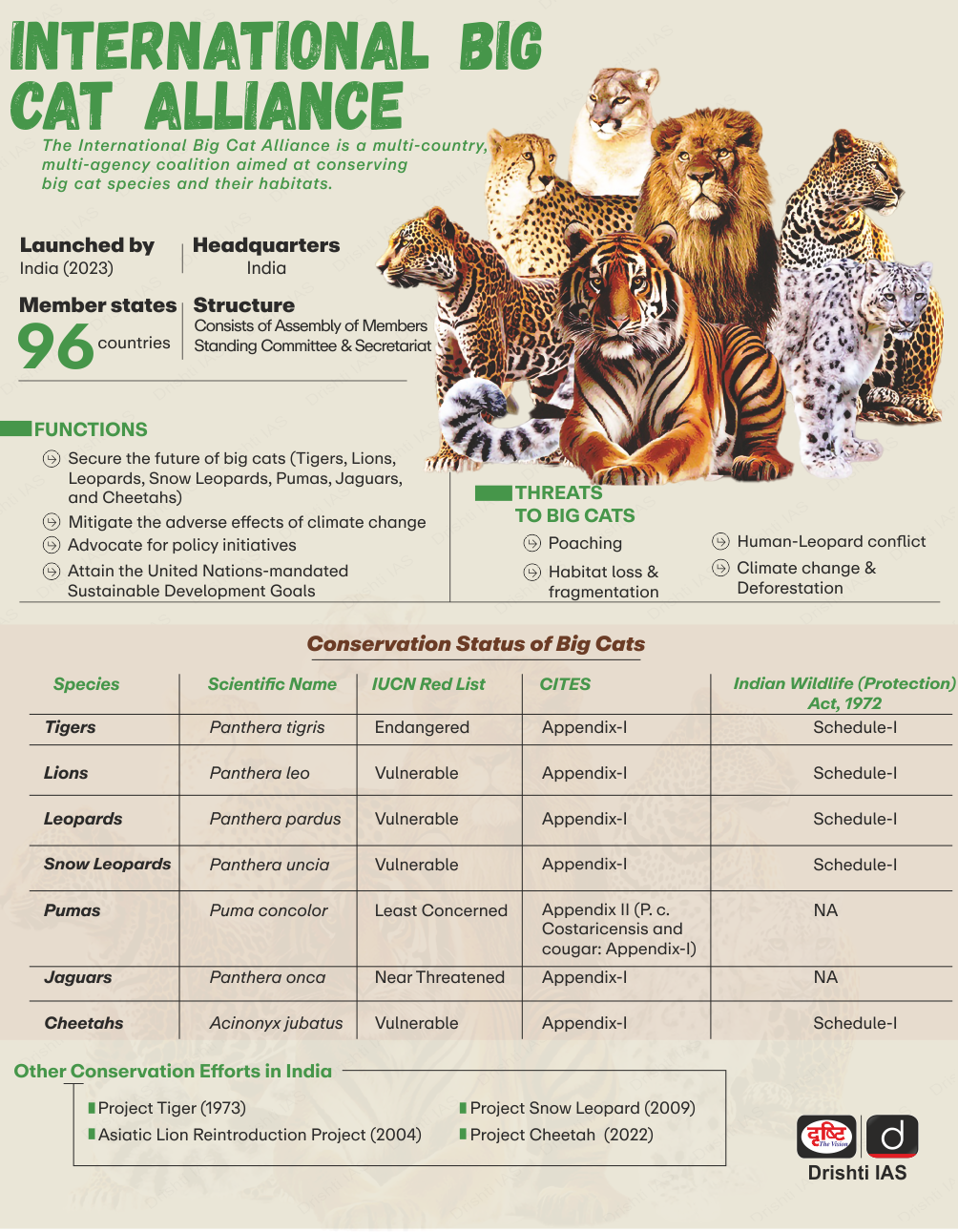
.png)
